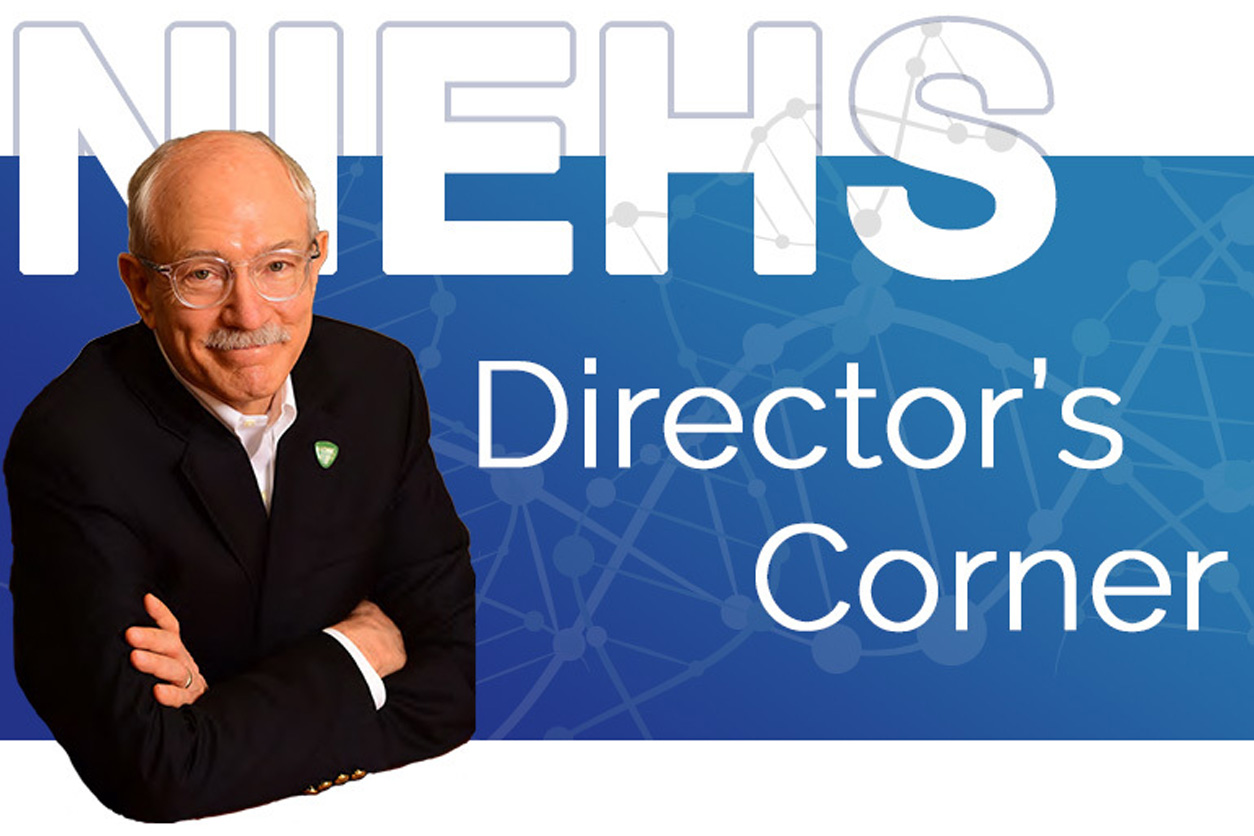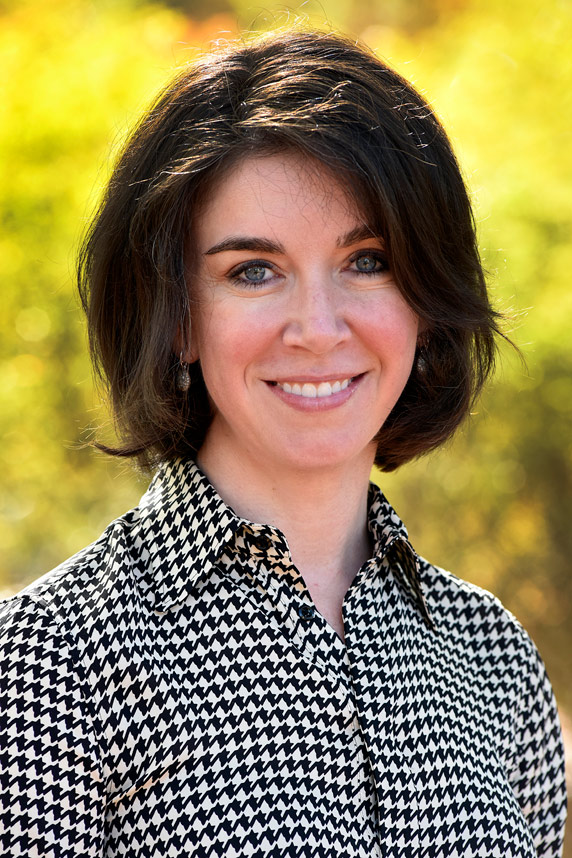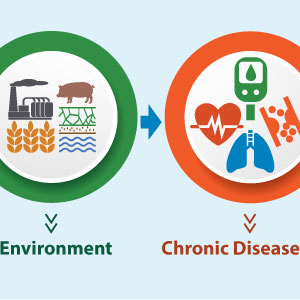 Rick Woychik, Ph.D., directs NIEHS and the National Toxicology Program. (Image courtesy of NIEHS)
Rick Woychik, Ph.D., directs NIEHS and the National Toxicology Program. (Image courtesy of NIEHS)Readers of this column may know that I am passionate about advancing research into how our genes interact with the totality of environmental exposures we experience throughout life, which is called the exposome. Studying one gene or one chemical at a time certainly can provide valuable scientific knowledge, but we need to do more to push the envelope, in my view.
To help promote healthier lives and prevent disease, researchers must grapple with the fact that individuals are unique in their genetic makeup and thus unique in how they respond to their surrounding environment, aspects of which are numerous and varied. At NIEHS, appreciation for that complex web of gene-environment interactions is reflected not just in our strategic plan but also in cutting-edge projects that I believe hold great promise.
One such project is the NIEHS Personalized Environment and Genes Study (PEGS), an initiative involving a cohort of 20,000 North Carolinians who have provided detailed information about their genes, health, and exposures. The study began almost 20 years ago and has since evolved due to scientific advances and new research methods. As a result, scientists will be able to learn more about genetic and environmental risk factors for a variety of conditions, such as heart disease and cancer, and eventually provide individualized risk assessments to study participants.
Recently, I spoke with the study’s lead researchers — NIEHS Clinical Director Janet Hall, M.D., and Alison Motsinger-Reif, Ph.D., who heads the institute’s Biostatistics and Computational Biology Branch. We discussed the history of PEGS, the value it will provide to both study participants and the research community, and long-term aims of the project. I also asked them about what sparked their interest in pursuing a scientific career (see sidebar).
Merging data on genes, health history, past exposures
 Hall leads the NIEHS Clinical Research Branch’s Reproductive Physiology and Pathophysiology Group and holds a secondary appointment in the institute’s Reproductive and Developmental Biology Laboratory. (Photo courtesy of Steve McCaw / NIEHS)
Hall leads the NIEHS Clinical Research Branch’s Reproductive Physiology and Pathophysiology Group and holds a secondary appointment in the institute’s Reproductive and Developmental Biology Laboratory. (Photo courtesy of Steve McCaw / NIEHS)Rick Woychik: Can you provide Environmental Factor readers with more insight into PEGS and what you hope to accomplish?
Janet Hall: NIEHS scientists were prescient back in the early 2000s when they conceived of a cohort of 20,000 individuals that would allow researchers to comprehensively assess genetic variation and its environmental influences as well as potential links to disease. I say “prescient” because this was before completion of the Human Genome Project, which paved the way for scientists to study an individual’s complete set of DNA, called the genome.
Our effort began with recruitment drives around North Carolina, and to date, we have individuals from almost every county in the state. We have tried to maintain regular contact with folks who first signed up and all people who later joined the study. So, in some cases, we have detailed genetic and health information from as far back as 2002, which is incredible.
Several years ago, we bolstered the project by surveying participants about their health conditions, toxic exposures they experienced, and factors such as sleep, diet, and medication. In addition, we sequenced whole genomes of 4,700 participants. We specifically chose these participants because they had provided us with the most complete data through our questionnaires.
Assessing how the environment affects gene expression
Alison Motsinger-Reif: The whole genome sequencing we have done provides us with a huge advantage because it means we are not limited to looking at a single genetic variant, which is what most other cohorts examine. That is important because the field has learned that single variant analysis, on its own, does not explain much about heritability or the origins of disease.
 Motsinger-Reif’s team focuses on the development and application of modern statistical approaches for understanding the origins of common, complex diseases. (Photo courtesy of Steve McCaw / NIEHS)
Motsinger-Reif’s team focuses on the development and application of modern statistical approaches for understanding the origins of common, complex diseases. (Photo courtesy of Steve McCaw / NIEHS)Also, we are adding an epigenetic component to PEGS, which I think is fantastic. Epigenetic analysis does not monitor changes in the DNA sequence but rather changes in how our genes are expressed because of exposure to chemicals. That is a key aspect of gene variation, and it is understudied because it only recently became technologically possible to do so on a large scale.
Opening the door for research innovation
RW: I think it is great that PEGS is generating so much important data. Two concepts that especially interest me are precision environmental health and the exposome. In February, I interviewed Dr. Cheryl Walker about the former, and in March, I interviewed Dr. Gary Miller about the latter. I think that PEGS advances both frameworks and will set the standard for gene-environment research going forward. What else would you like to share about this project?
JH: A unique aspect of PEGS is that we have been able to follow participants over time by asking about their longest-lived childhood address, longest-lived adult address, and current address. The power of that is that it allows us to link to public databases that go back many years and then examine participants’ proximity to nuclear power plants, airports, gas stations, toxic waste sites, commercial animal feeding operations, and other places. Through just information on addresses, we can also assess individuals’ exposures to fine particulate matter and ozone, among other substances, over time.
Recently, that information was compiled into databases that are interactive and readily accessible, and they will be valuable resources for the broader scientific community. We also have worked with the NIEHS Clinical Research Unit to call back participants and conduct follow-up studies. All in all, we are not the biggest cohort known to man, but we do have the most information, and I think that will open the door for impactful science going forward.
Advancing precision environmental health
AM-R: I hope that five years from now, we will have investigated the origins of some of the genetic and epigenetic variation seen in our PEGS cohort. We have an opportunity to shed light on how much of that variation is due to the environment and better understand how certain gene-environment interactions can lead to diseases observed in study participants. I should add that one strength of our study is our racial and ethnic diversity. For example, our cohort is about 30% African American, which is key to these results being more globally applicable.
Toward the concept of precision environmental health, we have started to evaluate disease risk assessment in the context of type 2 diabetes. We are comparing the predictive performance of polygenic risk scores, clinical risk scores, and environmental risk scores. So far, results show strongly that environmental risk scores have superior predictive performance and may be especially helpful for folks who want to know how susceptible they are to the condition.
Also, we hope that in the coming years, we can advance new approaches and best practices for scientists who want to integrate and use the kinds of diverse data generated through PEGS. The goal is to develop methods for studying gene-environment interactions that are useful beyond our cohort. We want other researchers to leverage what we have done, not recreate the wheel.
(Rick Woychik, Ph.D., directs NIEHS and the National Toxicology Program)









